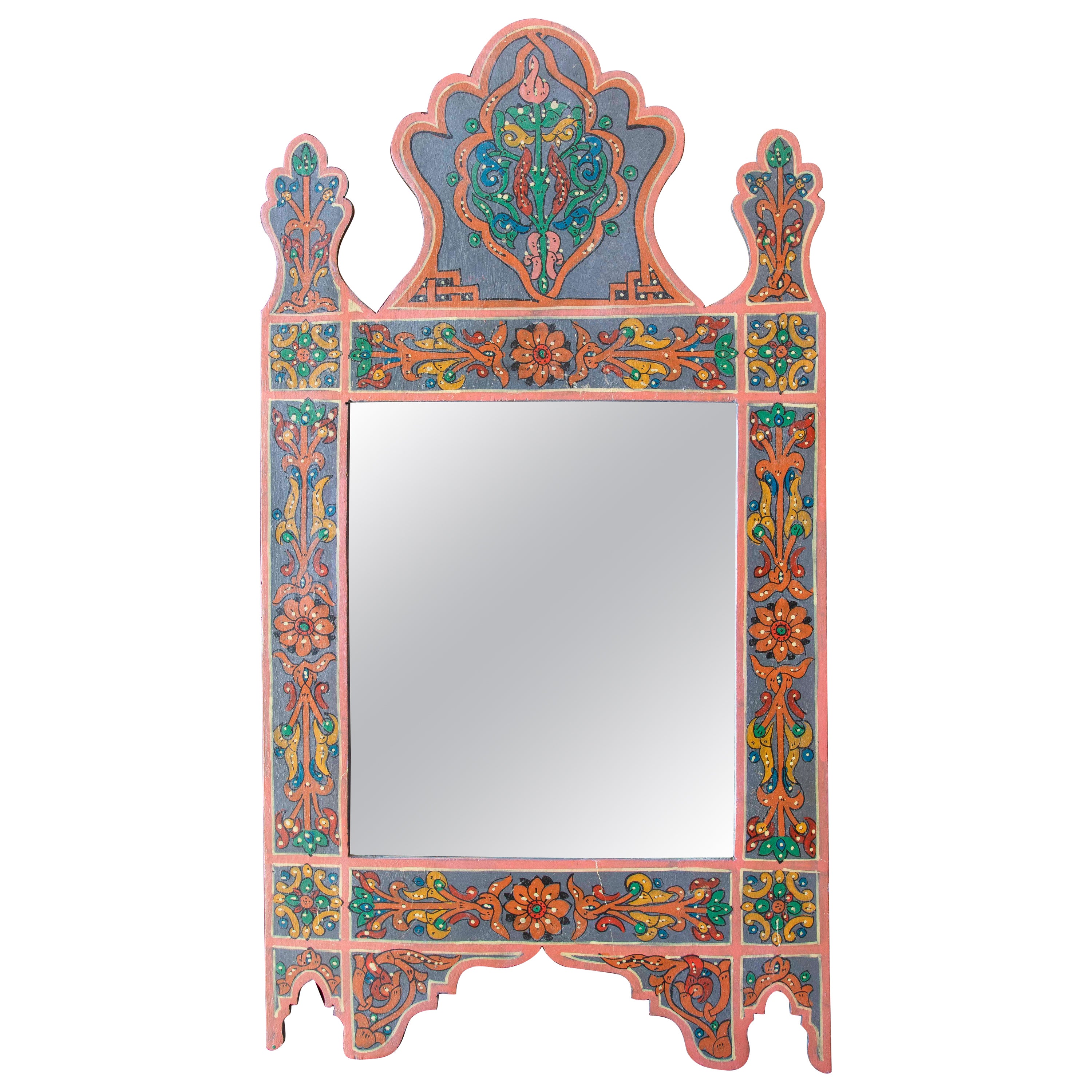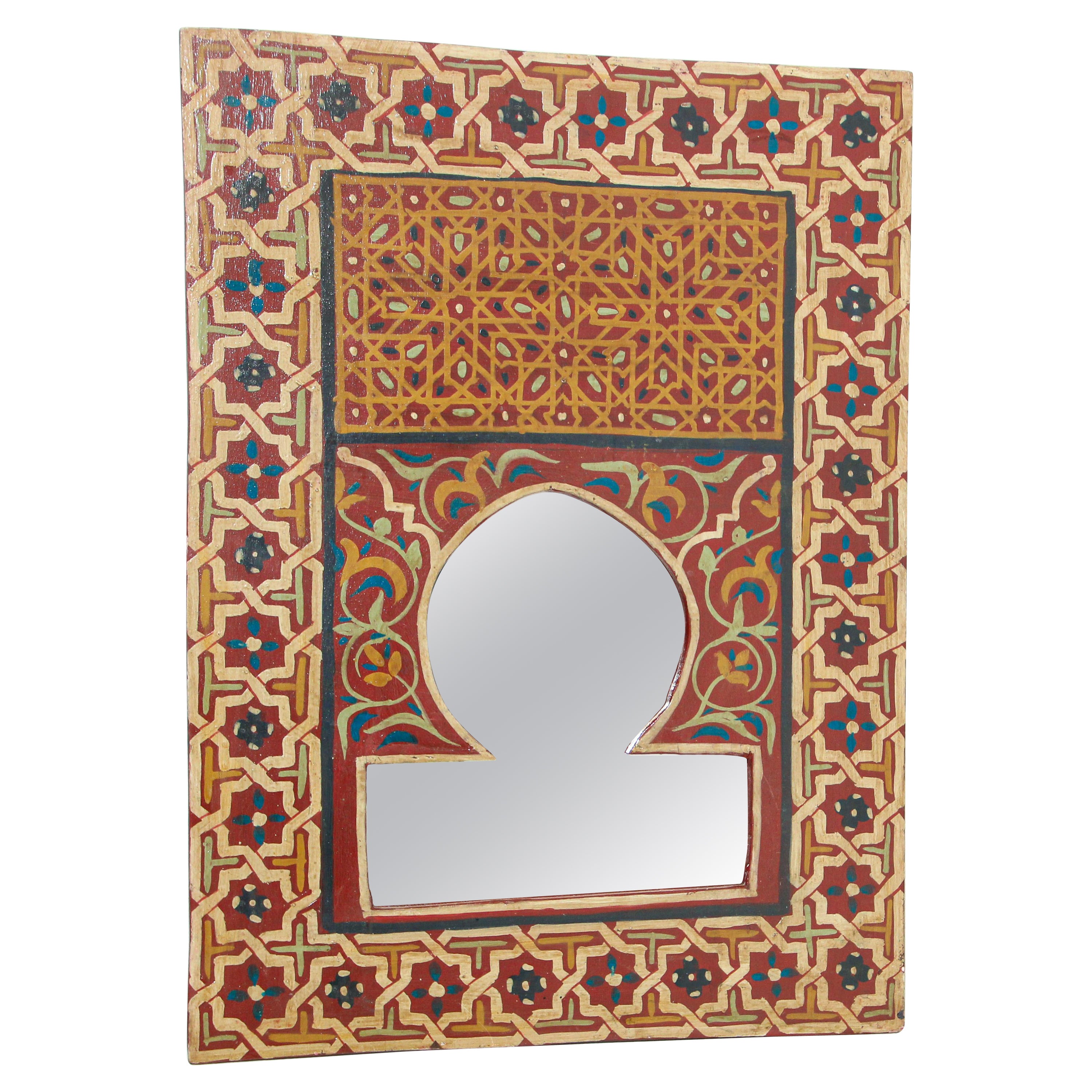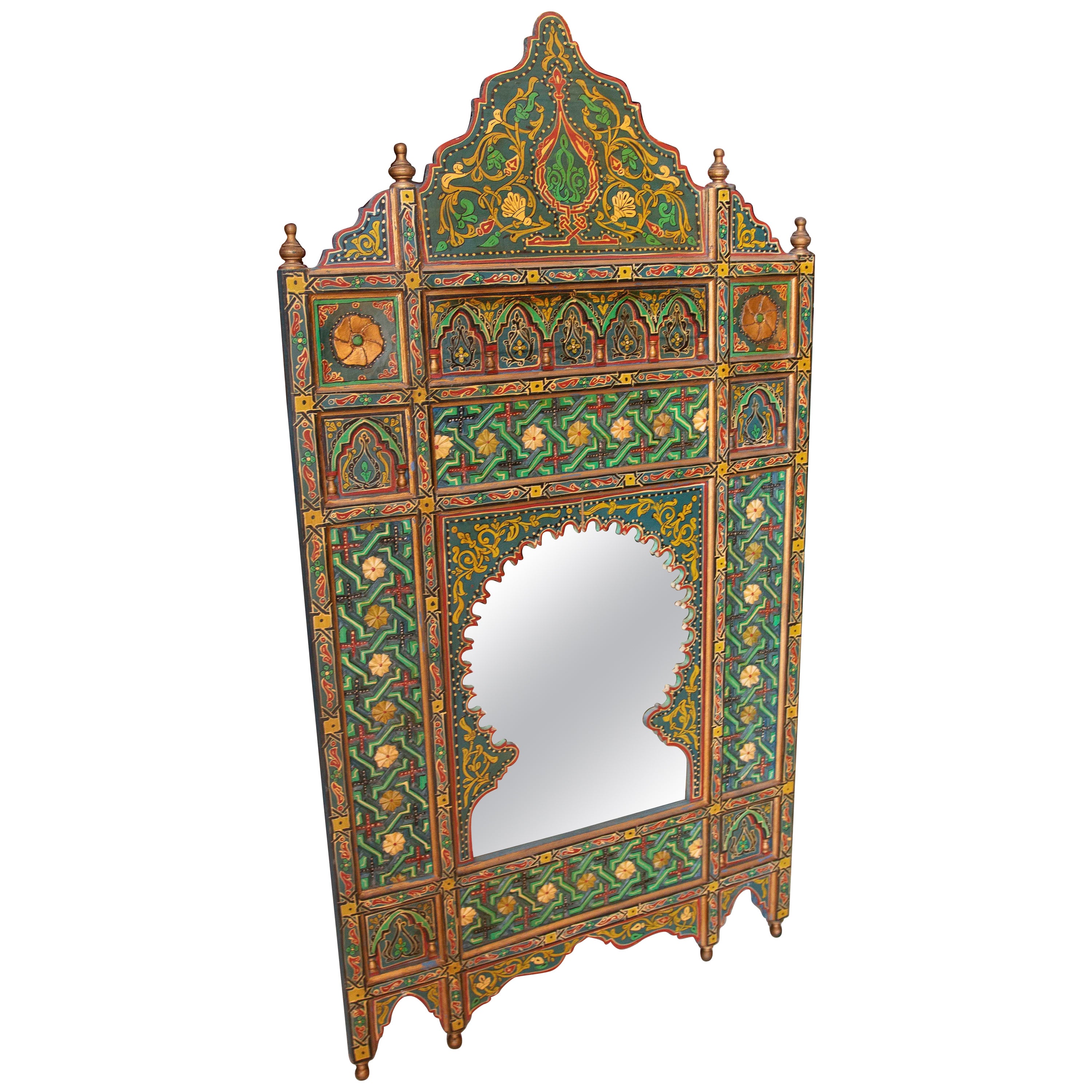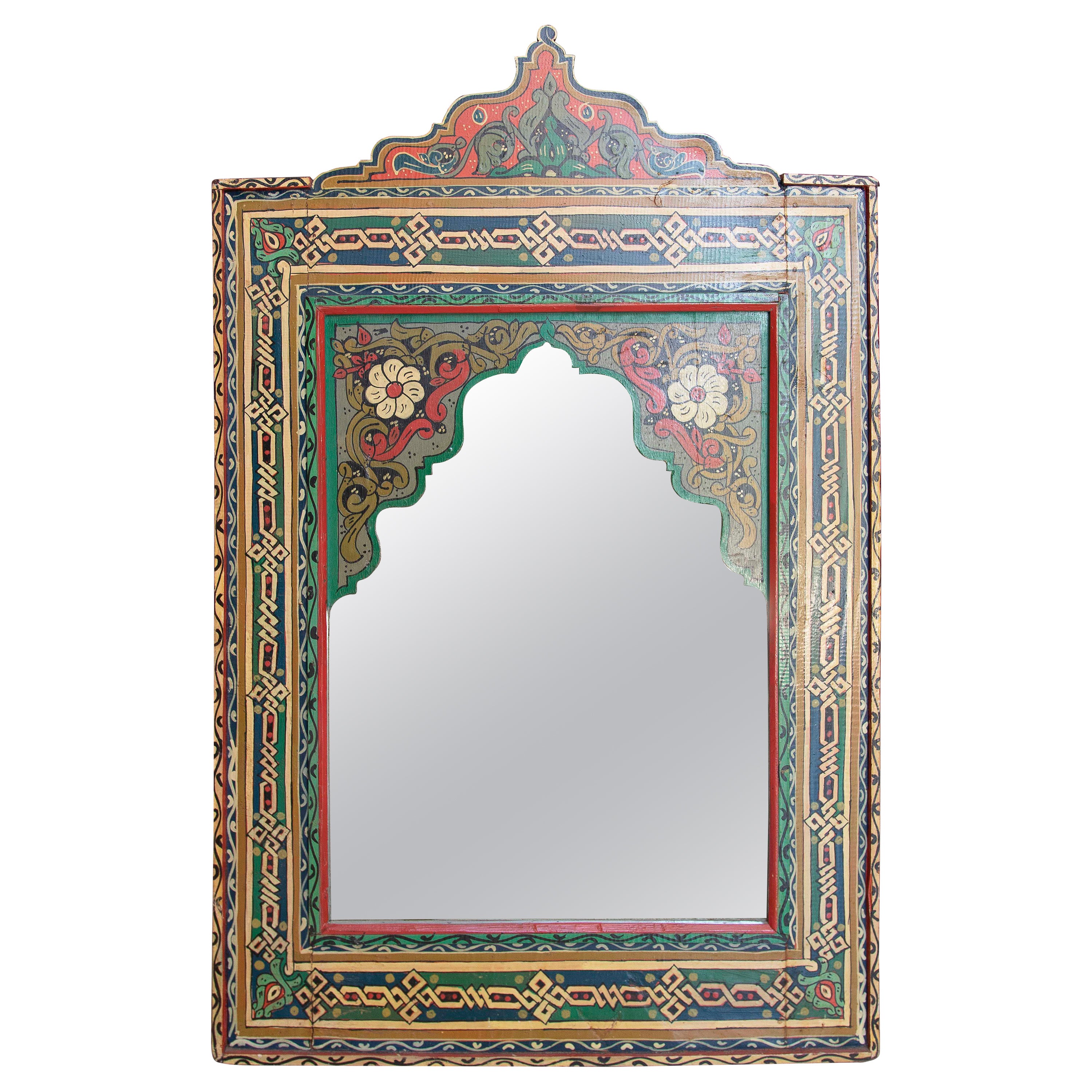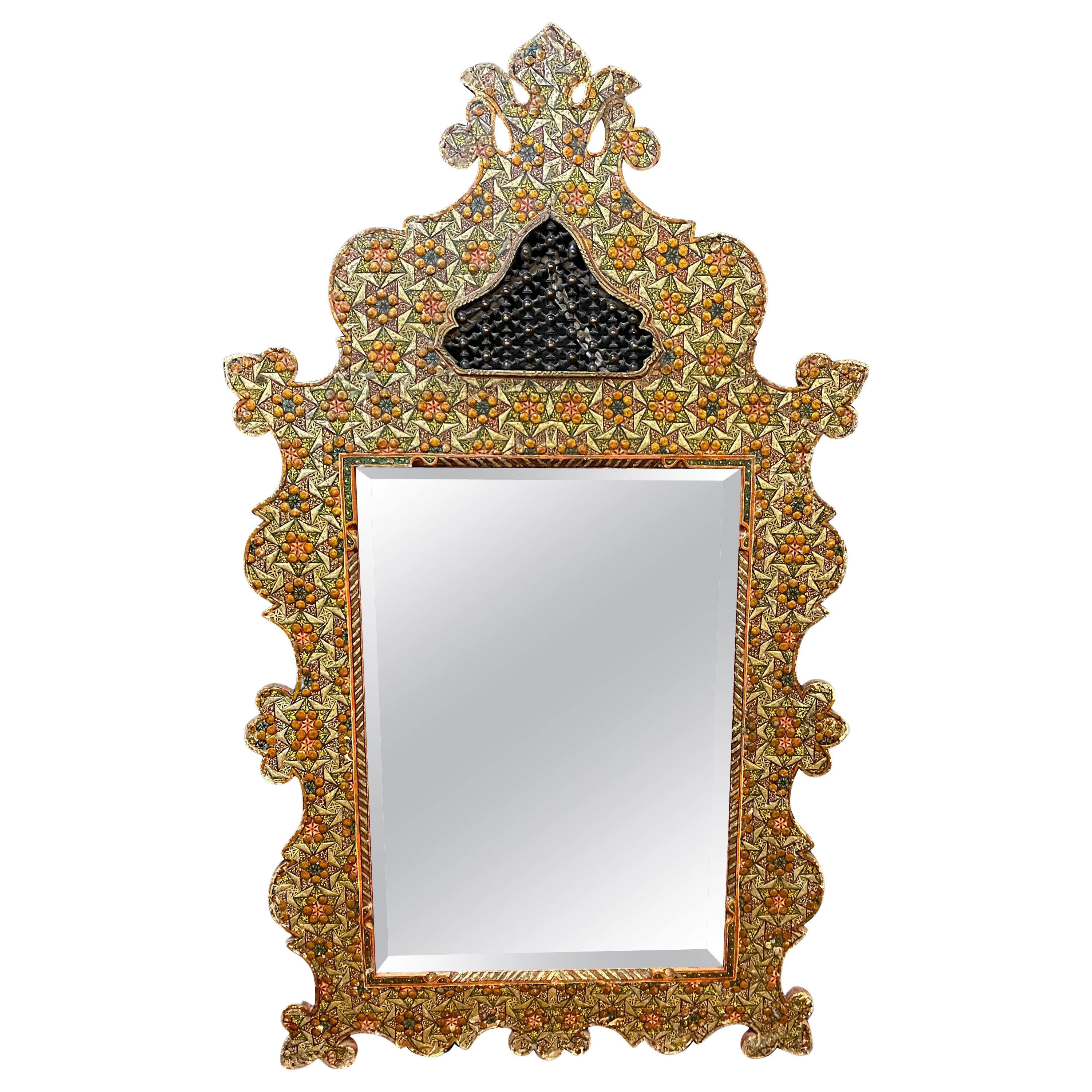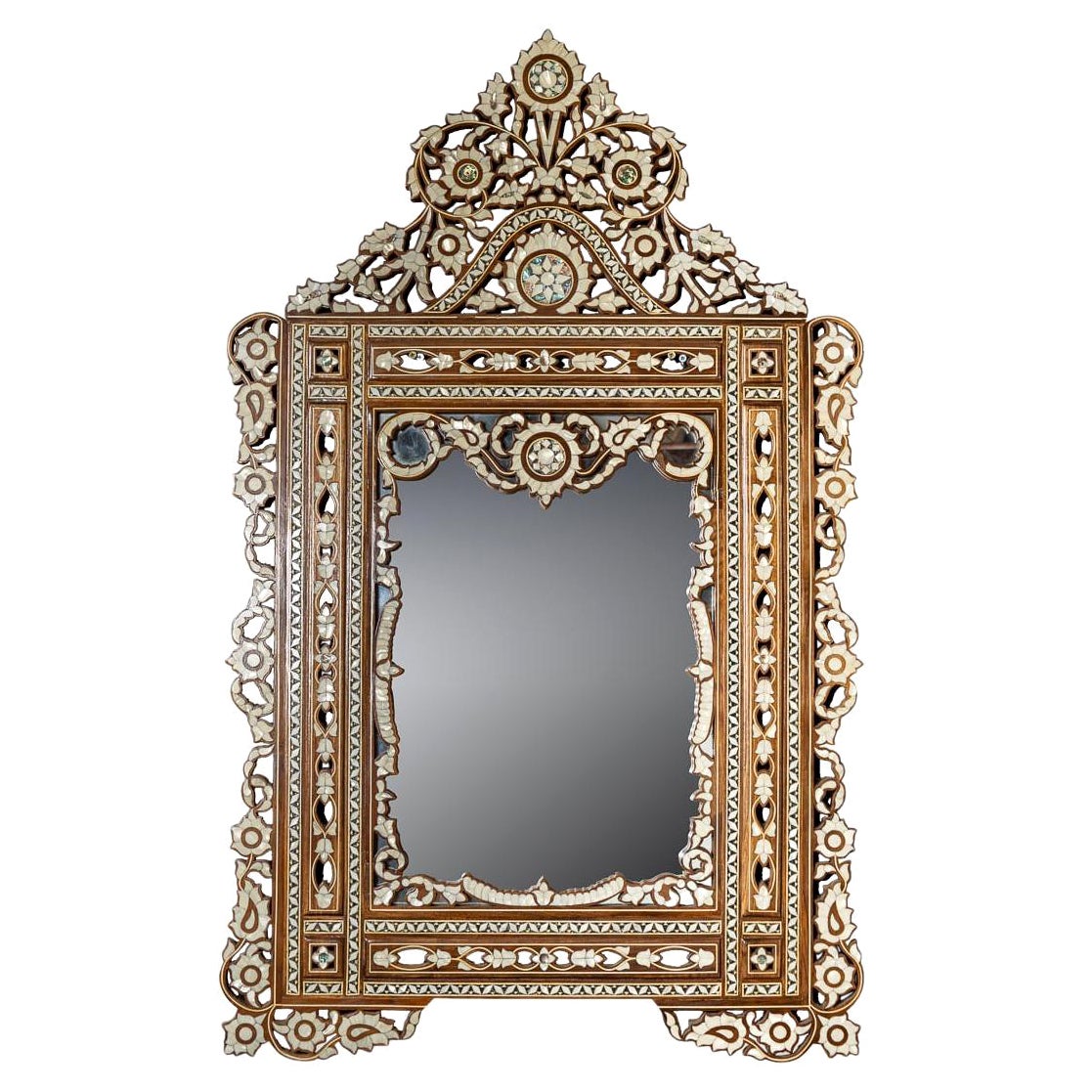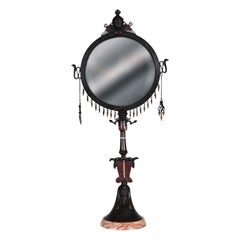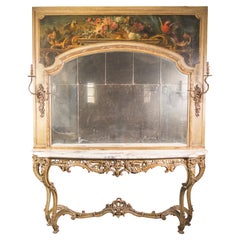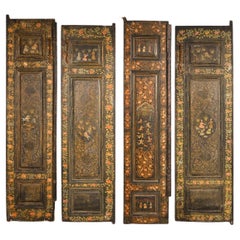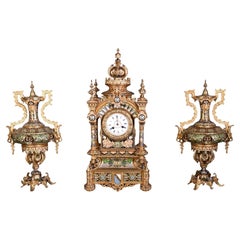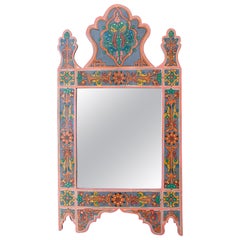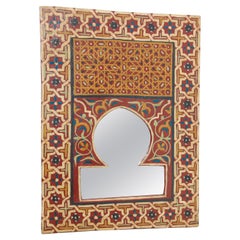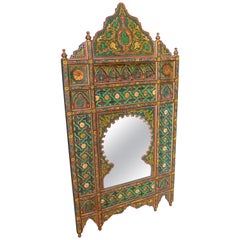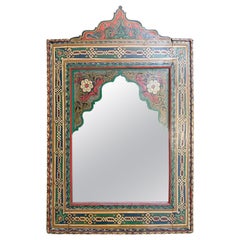Items Similar to Jacques Philippe Imberton, Oriental-Style Enameled Mirror
Want more images or videos?
Request additional images or videos from the seller
1 of 12
Jacques Philippe Imberton, Oriental-Style Enameled Mirror
$37,696.14
£28,001.93
€31,500
CA$52,004.46
A$57,167.21
CHF 30,044.46
MX$694,218.11
NOK 374,797.11
SEK 355,093.91
DKK 239,794.32
About the Item
This superb mirror with polychrome enamel decoration is an exceptional piece inspired by Nasrid art, representative of the architectural and decorative forms of the Alhambra Palace.
Mr. Philippe Imberton is, at the present time, the king of enamel; he sows it on the glass, with a prodigal and brilliant hand, early by large plates, sometimes by light veins, but in such a way as to always produce the happiest decorative effects.
Article by Louis Enault in La Presse, published on September 25th, 1884.
The geometric and vegetal patterns are a real innovative achievement in the glass enameling industry. Arranged on a rectangular mirror, the enamels are elegantly composed and colored to form a Nasrid-inspired decoration, representative of a Mudejar architecture, and manifesting the cultural and artistic exchanges in the Iberian Peninsula in the 12th and 16th centuries. The outline of enamels in the form of a horseshoe arch is a typical element of Arabic-Andalusian architecture, visible from early Christian churches to converted mosques.
The horseshoe arch is supported by very thin columns with a concave base and molded rings, a unique type of column that appears only in the Alhambra Palace and indicates the passage to a sacred or royal place. The capital is divided into two bodies, the first of which is cylindrical and has a voluptuous floral decoration. Above, a prism decorated with a plant frieze with a rounded base delicately curves the whole mirror.
I have rarely seen more power combined with greater skill.
Article by Louis Enault in La Presse, published on December 17th, 1880.
The talent of the enameler is rendered by the richness of the polychrome ornamentation of the vegetal patterns, notably by the arabesques of the polylobed arch, that is to say small contiguous arches, each ending in a pointed arch, also polylobed. These arches also evoke the muqarnas vault, one of the most impressive decorative elements among the ornamentation used in the Alhambra. The alfiz, the frame that surrounds the outside of the arch, is decorated with intricate bands of red and yellow floral filigree.
The entire portico is framed by regular and harmonious friezes, decorated with vegetal motifs and structured by lines of small white flowers. Six wild pomegranate flowers, also known as balaustes, are framed on a white enamel background by the eight-pointed star, a recurring figure throughout Islamic art. The flowers are slightly open and accompanied by small pomegranate seeds, a connotation of fertility and the literal symbol of the city of Granada, where the Alhambra is located. The decoration is also characterized by four mirrored fleur-de-lis, as if to express the meeting of the two monotheistic influences in Granada. We can see the extent of refinement in the detail of the rhinestone fixtures that attach the glass mirror to a wooden support.
While the representation of human figures in Muslim art is prohibited, the reflections of faces in the mirror naturally thwart the ban. One can read in an article of the Arts Industriels, published in La Presse on September 25, 1884, some lines notifying a mirror preceding ours: It will not displease the women either to find themselves beautiful by reflecting their fresh faces in this pretty oriental mirror, whose marvellous framing joins the charm of the motive to the splendour of the colorings.
The dynamic ornamentation finely worked highlights the Arabo-Andalusian influences of a lush vegetation, stylized with flowers and polychrome arabesques. The structured yet dreamlike appearance of the decoration gives this mirror a solemn and majestic look, adding depth to the silver-covered glass piece. The lines of the polylobed arch are characteristic of Ottoman architecture, as well as the use of vegetal motifs decorated with interlacing, geometric or floral networks. The complexity of the cloisonné enamels, a real innovation for the time, confirms the mastery the glassmaker.
Philippe Imberton affirmed his audacity and originality when he exhibited a remarkable oriental kiosk in the center of the great nave of the Palais de l'Industrie in 1880. He brought together all his savoir-faire, all his applications of enamel on different objects and supports. His stand presented numerous novelties such as stained glass enamel and enameled porcelain, a very successful attempt and "to which we believe a great future".
JACQUES-PHILIPPE IMBERTON
Originally from Portugal, Jacques-Philippe Imberton was a glassmaker, enameler and inlayer of first rank, recognized for his tireless research in the production of enamels on glass. He participated in the revival of the polychrome enameled glass industry in the 19th century, in which he was the inventor of a new enamelling process on glass that took his name.
After a period of oblivion linked to the decline of the seventeenth century, the multitude of enamelled glass pieces exhibited in 1878 at the Paris World Fair, including notable pieces by Philippe Imberton, contributed to the rediscovery of enamel on glass, as well as the Ottoman motifs which became a source of inspiration for Western ceramists. He worked in 1882 at Bucan and Duponthieu and realized some projects for the Appert brothers in Clichy. Between 1878 and 1891 he set up his workshops at 21 rue Rochechouart in the north of Paris, as well as a store at 38 boulevard des Italiens. He quickly developed an original style of his own, notably by the persistent use of turquoise blue and by his mixture of enamels, cloisonné with gold or vitrifiable colors, favored by a special composition that he applied by hand. The pieces are then blown and heated until the enamel is completely fused to the glass. His technique of enameling glass makes his pieces true works of art "with a sparkling and fragile substance", as much by the purity of the forms, the delicacy of the ornaments as by the richness of tone.
At the head of modern enameling, P. Imberton is distinguished by the rare and precious quality of his solid enamel and is thus closer to the great oriental artists. Indeed, the energetic sharpness of his colored enamels recalls the wonders found in the mosques of Cairo, Damascus or Constantinople, of which he will undertake some reconstructions of Arab masterpieces. Sometimes in the taste of the Renaissance, or in the Byzantine or Persian taste, he develops a new process of application of enamel on stained glass windows of the most original, where the enamel forms on the glass of brilliant laces, of an original design and an incomparable brightness. Some of his pieces are true specimens of luxury glassware, some of which are kept at the Corning Museum of Glass and the Museum of the Conservatoire National des Arts et Métiers. In 1884, he donated to the Conservatoire National des Arts et Métiers a collection of samples showing the successive stages of his technique of applying enamels to glass. His innovations, as well as his curiosity, earned him notable success at the Universal Exhibitions in which he participated, including those of 1878 in Paris, 1884 in Amsterdam, and 1888 in Barcelona, where he was awarded gold medals.
- Creator:Jacques-Philippe Imberton (Artist)
- Dimensions:Height: 31.5 in (80.01 cm)Width: 18.88 in (47.96 cm)Depth: 1.19 in (3.03 cm)
- Style:Moorish (In the Style Of)
- Materials and Techniques:
- Place of Origin:
- Period:
- Date of Manufacture:1886
- Condition:
- Seller Location:SAINT-OUEN-SUR-SEINE, FR
- Reference Number:Seller: 140421stDibs: LU7662243411362
About the Seller
No Reviews Yet
Recognized Seller
These prestigious sellers are industry leaders and represent the highest echelon for item quality and design.
1stDibs seller since 2022
Typical response time: 10 hours
- ShippingRetrieving quote...Shipping from: SAINT-OUEN-SUR-SEINE, France
- Return Policy
Authenticity Guarantee
In the unlikely event there’s an issue with an item’s authenticity, contact us within 1 year for a full refund. DetailsMoney-Back Guarantee
If your item is not as described, is damaged in transit, or does not arrive, contact us within 7 days for a full refund. Details24-Hour Cancellation
You have a 24-hour grace period in which to reconsider your purchase, with no questions asked.Vetted Professional Sellers
Our world-class sellers must adhere to strict standards for service and quality, maintaining the integrity of our listings.Price-Match Guarantee
If you find that a seller listed the same item for a lower price elsewhere, we’ll match it.Trusted Global Delivery
Our best-in-class carrier network provides specialized shipping options worldwide, including custom delivery.More From This Seller
View AllGiuseppe PARVIS (attributed to), Egyptian Revival Mirror
Located in SAINT-OUEN-SUR-SEINE, FR
This mirror, with its Egyptian-style design, was created by Giuseppe Parvis around 1900.
Giuseppe Parvis (1831-1909) studied at the Accademia Albertina in Turin. Fascinated by Egypt...
Category
Antique Early 1900s Italian Egyptian Revival Table Mirrors
Materials
Marble, Bronze
Louis XV style console and its mirror
Located in SAINT-OUEN-SUR-SEINE, FR
Important antique Louis XV style console, with a mirror and surmounted by a still life painting, made in the 19th century. The console is made out of lacquered wood and the table top...
Category
Antique 19th Century French Louis XV Furniture
Materials
Marble
Qajar Art, Set of doors decorated with major scenes of Persian life
Located in SAINT-OUEN-SUR-SEINE, FR
These magnificent lacquered doors in wood and papier-mâché were produced in Persia toward the end of the 19th century. Qajar art flourished between 1786 and...
Category
Antique Late 19th Century Persian Islamic Doors and Gates
Materials
Wood, Paper
Persian-style double-sided clock and garnitures, Charles Stanislas MATIFAT
By Charles Matifat
Located in SAINT-OUEN-SUR-SEINE, FR
Charles Stanislas Matifat is the creator of this ensemble consisting of a double-sided enameled bronze clock and a matching pair of large garnitures. Dated 1851 and bearing his signa...
Category
Antique 19th Century European Islamic Table Clocks and Desk Clocks
Materials
Bronze, Enamel
Carlo BUGATTI, Pair of Moorish-Style Wall Sconces
By Carlo Bugatti
Located in SAINT-OUEN-SUR-SEINE, FR
This asymetric pair of wall sconces is quintessentially characteristic of Carlo Bugatti’s art, designed by him around 1888.
Carlo Bugatti (1856-1940) trained at the Brera Academy in...
Category
Antique Late 19th Century Italian Moorish Wall Lights and Sconces
Materials
Brass, Copper
Armand Albert RATEAU (création) Baguès FRÈRES (exécution) double-porte Art déco
By Maison Baguès, Armand Albert Rateau
Located in SAINT-OUEN-SUR-SEINE, FR
This double door, based on a drawing by Albert Rateau, is a model very similar to the entrance of the Pavillon de l’Élégance at the International Exhibition of Modern Decorative and ...
Category
Vintage 1920s French Art Deco Doors and Gates
Materials
Wrought Iron
You May Also Like
Hand-painted Moorish Style Wooden Wall Mirror with Decorations
Located in Marbella, ES
Hand-painted Moorish Style Wooden Wall Mirror with Decorations
Category
Late 20th Century Moroccan Moorish Wall Mirrors
Materials
Mirror, Wood
Vintage Moroccan Mirror Hand Painted with Red and Amber Moorish Design
Located in Moreno Valley, CA
Vintage Moroccan mirror, hand painted, wooden Moorish window shaped mirror.
Beautiful hand crafted mirror in a traditional hand painted Mooris...
Category
Late 20th Century Moroccan Moorish Wall Mirrors
Materials
Mirror, Wood, Paint
Hand-painted Moorish Style Wooden Wall Mirror with Decorations
Located in Marbella, ES
Hand-painted Moorish Style Wooden Wall Mirror with Decorations
Category
Late 20th Century Moroccan Moorish Wall Mirrors
Materials
Mirror, Wood
Hand-painted Moorish Style Wooden Wall Mirror with Decorations
Located in Marbella, ES
Hand-painted Moorish Style Wooden Wall Mirror with Decorations
Category
Late 20th Century Moroccan Wall Mirrors
Materials
Mirror, Wood
Old large oriental mirror in engraved and polychromed wood; beveled mirror
Located in Saint-Ouen, FR
Old large oriental mirror in engraved and polychromed wood;
beveled mirror
small paint losses
Category
Antique Late 19th Century Maghreb Moorish Wall Mirrors
Materials
Wood
Antique 20th Century Moorish Inlaid Levantine Mirror c.1900
Located in Royal Tunbridge Wells, Kent
Antique early 20th-century Levantine inlaid mirror, meticulously handcrafted from durable hardwood. The exterior is adorned with intricate patterns made from mother of pearl and abal...
Category
20th Century European Other Wall Mirrors
Materials
Mirror, Wood
More Ways To Browse
Antique Mosque
Antique Vault
Portuguese Blue And White Plates
Jacques Philippe
Fleur De Lis Stained Glass
Arched Ottoman
6 Foot Mirror
9 Panel Mirror
Acanthus Wood Carving
Alguacil & Perkoff Ltd. On Sale
American Duplex
Antique Cast Iron Window Mirror
Antique Frameless Wall Mirror
Artimeta Mirror
Balls Wood Mirror
Barbara Barry Mirror
Bathroom Console Sink
Batwing Mirror
